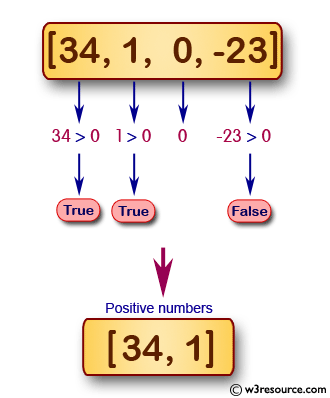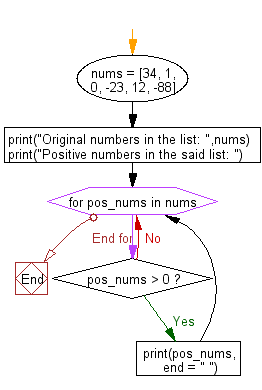Python: Filter the positive numbers from a list
Filter Positive Numbers
Write a Python program to filter positive numbers from a list.
Positive Numbers: Any number above zero is known as a positive number. Positive numbers are written without any sign or a '+' sign in front of them and they are counted up from zero, i.e. 1, + 2, 3, +4 etc.
Pictorial Presentation:

Sample Solution-1:
Python Code:
# Define a list named "nums" containing a series of integers.
nums = [34, 1, 0, -23, 12, -88]
# Print a message along with the original list of numbers.
print("Original numbers in the list: ", nums)
# Create a new list "new_nums" by using the "filter" function with a lambda function
# that filters out positive numbers from the "nums" list.
new_nums = list(filter(lambda x: x > 0, nums))
# Print a message along with the list of positive numbers from the "nums" list.
print("Positive numbers in the said list: ", new_nums)
Sample Output:
Original numbers in the list: [34, 1, 0, -23, 12, -88] Positive numbers in the said list: [34, 1, 12]
Sample Solution-2:
Python Code:
# Define a list named "nums" containing a series of integers.
nums = [34, 1, 0, -23, 12, -88]
# Print a message along with the original list of numbers.
print("Original numbers in the list: ", nums)
# Print a message indicating that positive numbers in the list will be listed.
print("Positive numbers in the said list: ")
# Iterate through each number in the "nums" list.
for pos_nums in nums:
# Check if the number is greater than 0 (positive).
if pos_nums > 0:
# Print positive numbers on the same line with a space separator.
print(pos_nums, end=" ")
Sample Output:
Original numbers in the list: [34, 1, 0, -23, 12, -88] Positive numbers in the said list: 34 1 12
Flowchart:

Sample Solution-3:
Python Code:
# Define a list named "nums" containing a series of integers.
nums = [34, 1, 0, -23, 12, -88]
# Print a message along with the original list of numbers.
print("Original numbers in the list: ", nums)
# Create a new list "pos_nums" using a list comprehension to filter positive numbers from "nums."
# Positive numbers are those greater than 0.
pos_nums = [n for n in nums if n > 0]
# Print a message indicating that positive numbers in the list will be listed,
# followed by the positive numbers separated by a space.
print("Positive numbers in the said list: ", *pos_nums)
Sample Output:
Original numbers in the list: [34, 1, 0, -23, 12, -88] Positive numbers in the said list: 34 1 12
For more Practice: Solve these Related Problems:
- Write a Python program to filter negative numbers from a list.
- Write a Python program to remove zero values from a list.
- Write a Python program to find all even numbers in a list using the filter function.
- Write a Python program to count the number of positive numbers in a list.
Go to:
Previous: Write a Python program to input a number, if it is not a number generates an error message.
Next: Write a Python program to compute the product of a list of integers (without using for loop).
Python Code Editor:
What is the difficulty level of this exercise?
Test your Programming skills with w3resource's quiz.
